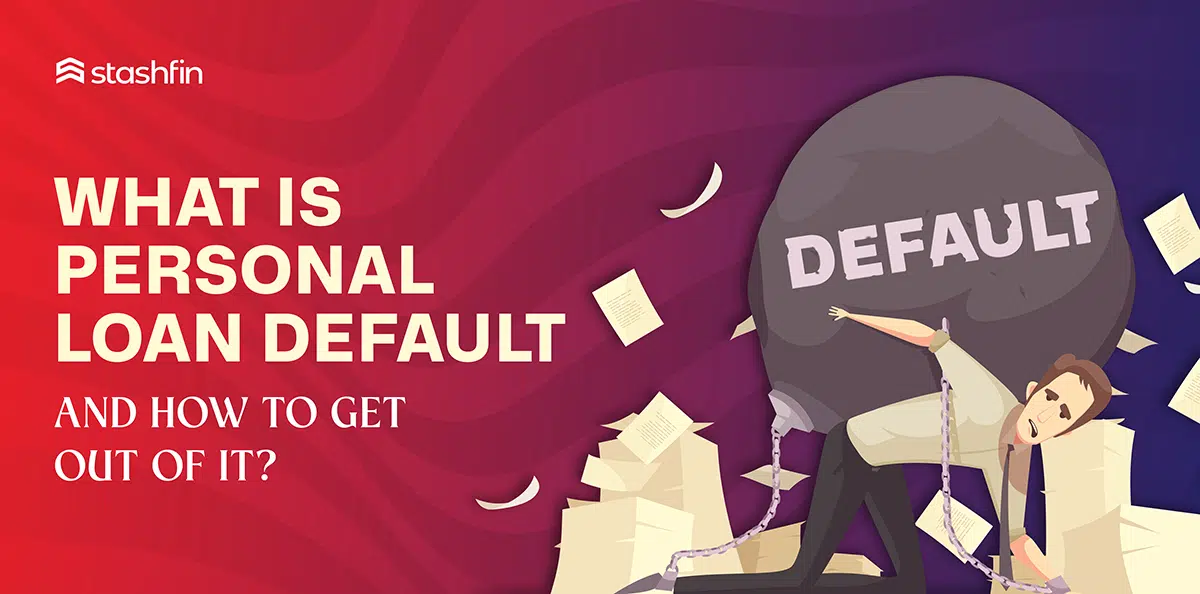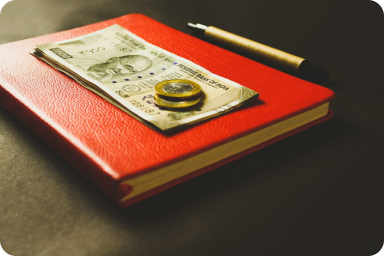Published
What is Personal Loan Default and How to Get Out of It?
Table of contents

Facing a personal loan default can be a stressful and overwhelming experience, but understanding what it means and the steps you can take to resolve it can make all the difference. A personal loan default occurs when a borrower fails to make loan payments as agreed, which can lead to serious financial consequences, including damage to credit scores, increased interest rates, and potential legal actions. But don’t worry – there are practical strategies to help you recover, regain control of your finances, and get back on track. In this guide, we’ll explore the meaning of personal loan default, its consequences, and effective ways to get out of it, ensuring a smoother path to financial stability.
What is a Personal Loan Default?
Personal loan default occurs when a borrower fails to meet the repayment terms outlined in their loan agreement, typically by missing several consecutive payments. It is often marked by a specific period of non-payment, which can vary by lender but usually ranges from 90 to 180 days. Once in default, the lender may take further actions, such as increasing interest rates, charging late fees, reporting the delinquency to credit bureaus, or initiating legal proceedings to recover the outstanding loan amount. Defaulting on a personal loan can significantly impact a borrower’s credit score and make it more challenging to obtain credit in the future.
StashFin offers a hassle-free way to access personal loans online with instant approval, competitive interest rates, and flexible repayment options.
Why Do People Default on Personal Loans?
Some of the common reasons why people default on personal loans are:
1. Financial Difficulties: Life cannot be predicted. Sometimes, unexpected things can happen in life. For instance, a job loss, some medical problems, or the sudden downfall of the economy are all examples of unexpected financial setbacks.
As a borrower, these financial hardships can make it difficult for you to repay the loan as you had planned earlier. It could lead to financial problems while missing out on the respective loan payment.
2. Excessive Debt Burden: When you accumulate excess debt from different sources, it will ultimately affect your overall financial capacity. In case the total debt crosses ability of an individual to repay the amount, it is easier to default on a personal loan.
3. Improper Financial Management: Improper budgeting and financing can be damaging to your overall credit portfolio, even impacting your loan repayment. This is because you might struggle to allocate proper funds necessary for loan repayments. When you practice uncontrolled spending habits and overall financial disorganization, it could lead to defaulting on loans.
4. Not Being Aware of Loan Terms: In some cases, borrowers might not be fully aware of their specific loan terms and conditions. With this lack of understanding, they might end up doing unintentional defaults because of missed deadlines or not fulfilling specific conditions.
What are the Consequences of Personal Loan Default?
A personal loan with default can lead to several serious consequences, affecting both your financial and personal life. Here are some key repercussions of a personal loan with default:
- Negative Impact on Credit Score:
Missing loan payments and entering default status can significantly damage your credit score. It makes it harder to secure credit in the future, as lenders view borrowers with default histories as higher risk.
- Increased Interest and Late Fees:
Once a personal loan goes into default, lenders often apply late fee penalties and sometimes increase interest rates, which makes the debt even harder to manage and repay.
- Legal Actions:
In cases of prolonged default, lenders may initiate legal proceedings to recover the outstanding loan amount. It could lead to wage garnishment or asset seizure, depending on the local laws and loan terms.
- Difficulty in Future Borrowing:
A personal loan with a default on your credit report makes it difficult to get approved for future loans or credit cards, as most lenders are cautious with individuals who have a history of non-repayment.
- Stress and Mental Health Impact:
The stress of dealing with unpaid debt and collection actions can take a toll on mental health, adding a personal dimension to the financial consequences of loan default.
It is essential to communicate with your lender early and explore options to avoid default if you are struggling with payments, as they may offer restructuring grace periods or alternate repayment plans.
Can Loan Restructuring Help Prevent Default?
Yes. Loan restructuring is an effective way when it comes to preventing a potential loan default. With loan restructuring, you can modify the respective loan terms to ensure that loan repayment is more manageable, especially if you are facing financial difficulties.
In case of a loan restructuring, you might consider extending the loan tenure, minimizing interest rates, or asking for some temporary relief on the loan payments. With these minor adjustments, you can potentially lower the overall burden of loan repayment and make it easier for you to stay current on your loans.
In case you are struggling with unpredictable circumstances, like a job loss, economic downturns, or medical emergencies, loan restructuring offers you ample relief. Borrowers can negotiate loan terms with the lender and minimize major consequences, including legal action, credit score damage, or asset repossession.
In some ways, lenders also benefit from the concept of loan restructuring. This is because the practice allows lenders to recover the loan instead of dealing with losses and defaults.
How to Prevent Personal Loan Default?
Preventing personal loan default requires proactive planning, responsible borrowing, and financial discipline. These are a few tips on “how to prevent a loan default”:
- Borrow What You Can Repay:
Assess your financial situation and borrow only the amount that you can comfortably repay. Avoid overextending yourself with a high loan amount that would strain your budget.
- Select Appropriate Loan Tenure:
Choose the type of loan tenure so that your installment will not burden you. Long-term tenures have relatively low installments; thus, one cannot lose track of payments, but he will surely pay more interest.
- Automate Repayment of Loans:
Subscribing to an auto-pay process ensures that you will never miss any due date. Most banks and lending organizations offer you the facility of auto-pay. Once opted, they will deduct the amount from your bank account.
- Budget and Emergency Account:
Planning the monthly budget frees money for loan repaying. Having an emergency account helps meet payments in case of unexpected expenses or loss of income.
- Contact Your Lender:
If you’re having trouble keeping up with your payments, contact your lender right away. He or she can modify your payment schedule or offer any other form of relief allowed by your lender, like a moratorium or reduced terms of payment.
- Avoid Taking On Multiple Loans at One Time:
Having numerous loans can put your ability to pay back the debt in jeopardy and raise your likelihood of default. It is less risky to take one loan at any given time.
Through the above techniques, you are likely to reduce your chances of defaulting on a personal loan, which will save you your credit rating and stability in financial conditions.
How to Get out of Personal Loan Default?
Getting out of a loan default seems like an extremely daunting task, but if done with the right plan, it’s perfectly doable. Here follows “how to get out of a loan default”:
- Communicate with Your Lender:
The first step is to contact your lender. Explain your situation to him and discuss options such as how to adjust repayment plans, take reduced settlement, or even forbearance.
- Consider Loan Rehabilitation Programs:
Most lenders have rehabilitation programs designed to allow the gradual rehabilitation of your loans back to good standing. It usually provides a smaller number of payments that are manageable enough to help revive the status of your loan.
- Negotiate a One-Time Settlement:
In case you do not intend to repay the full amount, there is a chance that you can settle the loan in part. A one-time settlement is an arrangement wherein you pay a reduced amount and shut the account.
- Seek Consolidation for Debts:
Consolidation loans, if you are eligible, can be used to clear defaulted loans by putting all the debts together, thus having one monthly payment and perhaps with a lower interest rate.
- Increase your sources of Income:
Temporary sources of income help boost up funds for overdraft payments. Sometimes, one may opt for sideline jobs, freelancing, or selling items not regularly used in order to catch up.
- Seeking Expert Financial Advice:
A financial advisor or credit counsellor must be able to come up with particular strategies for rebuilding your finances and plan for credit recovery.
These steps help find practical solutions to resolve any loan default, how to gradually rebuild credit, and work toward financial stability.
Rebuilding Credit After a Personal Loan Default
Rebuilding your credit after a personal loan with unpaid defaults can be challenging but not impossible. This a roadmap to help you regain financial health and improve your credit profile:
- Settle the Outstanding Debt:
Begin by addressing the unpaid defaults. If possible, negotiate with your lender to reach a settlement that closes the account or reduces the total amount owed. Clearing this debt can prevent further damage to your credit score.
- Establish a Consistent Payment History:
Late or missed payments from previous defaults hurt your score, so focusing on consistent, timely payments going forward is essential. Start with smaller, manageable obligations and make timely payments each month to gradually build trust with credit agencies.
- Consider a Secured Credit Card: loans
If obtaining a traditional loan is difficult, using a secured credit card can help rebuild credit. It requires a deposit as collateral but can establish a positive payment history when used responsibly.
- Monitor Your Credit Report Regularly:
Keeping an eye on your credit report helps you track improvements and spot any errors that might be holding back your score. Clearing errors can provide a much-needed boost to your credit score.
- Use a Mix of Credit:
Diversifying your credit types, such as through small, low-interest loans or retail installment plans, can positively impact your score. A combination of revolving (credit cards) and installment credit can showcase responsible handling of various credit forms.
- Work with a Credit Counseling Service:
If you are unsure where to begin, a reputable credit counselling service can offer personalized strategies to rebuild your credit and address outstanding debts effectively.
Patience and financial discipline are key to restoring your credit after a personal loan with unpaid defaults. Consistently practising good credit habits will gradually bring positive changes, enhancing your financial reputation over time.
Conclusion
Knowing the consequences of a personal loan default is essential for maintaining financial stability. A default can lead to credit score damage, increased debt from penalties, and even legal repercussions. However, taking proactive steps to get a loan out of default can help you regain control over your finances. By communicating with lenders, setting up repayment plans, and adopting better money management habits, you can gradually rebuild your credit and move forward. Remember, addressing a personal loan default not only prevents further financial strain but also sets you on a path to long-term financial health.
Whether you need funds for an emergency, a purchase, or a special occasion, StashFin’s personal loans provide quick solutions with minimal documentation and fast disbursal. Apply now and experience seamless, secure financing tailored to your needs!
Frequently Asked Questions
How long does it take for a personal loan to go into default?
A personal loan typically defaults if payments are missed for an extended period, usually between 30 to 90 days, depending on the lender’s specific policies. Some lenders may classify a loan as “delinquent” after a single missed payment, but it becomes “defaulted” after continued non-payment over several months. Exact timelines can vary, so it’s best to check with your lender to understand their policy on defaults.
How does a personal loan default affect your credit score?
Personal loan default has a serious impact on your credit score. The moment you default on a loan, the lender will file a bad credit with the bureaus; this bad credit can appear on your credit report for up to seven years. The default will likely cause a pretty severe deterioration in your credit score, which can then make it much more difficult to borrow future monies, for example, loans or credit cards. Additionally, a lower credit score can lead to higher interest rates and less favourable loan terms when you do get approved for credit.
What are the options for dealing with a personal loan default?
If you are defaulting on a personal loan, there are options that you can take to resolve the issue, such as contacting the lender, debt restructuring, debt consolidation, refinancing the loan, seeking professional help, selling assets, and filing for bankruptcy. Taking immediate action and looking into such options well in advance can help you minimize the impact of defaulting on a personal loan.
Can bankruptcy help in resolving a personal loan default?
Yes, bankruptcy can resolve a personal loan default, but has severe long-term consequences and should generally be considered only as a last resort.
What is the difference between personal loan defaults and late payments?
Late payments are a temporary setback, and if addressed promptly , they should not have lasting effects, though they would still impact your credit score while the default is a more serious situation that arises due to non-payment over a prolonged period of time. It may end up having more critical implications, like serious damage to your credit score, legal action, and potential debt collection.
- All Posts
- All topics
- Bonds
- Cash Loan
- Child Education Insurance
- Corporate Bond
- Credit Cards
- Credit Report
- Credit Score
- Critical Illness Insurance
- Customer Success
- Cyber Insurance
- Design
- EMI Calculator
- EPF
- Expense Management
- Finance
- Home Appliance Insurance
- Home Insurance
- Industry News
- Instant Loan
- Insurance
- loan
- Loan Protection Insurance
- Medical Loans
- Mobile Loan
- Personal Loans
- Product
- Salary Protection
- Sentinel App
- Small Loan
- Software Engineering
- Stashfin App
- TeleMarketing
- Testimonials
- Trading Account
- Travel Insurance
- Wallet Protection
- Wedding Loans

A personal loan is often a saviour when you need financial assistance. Personal loans are flexible and accessible for various...

Taking out a personal loan is a common financial solution for meeting various expenses,...